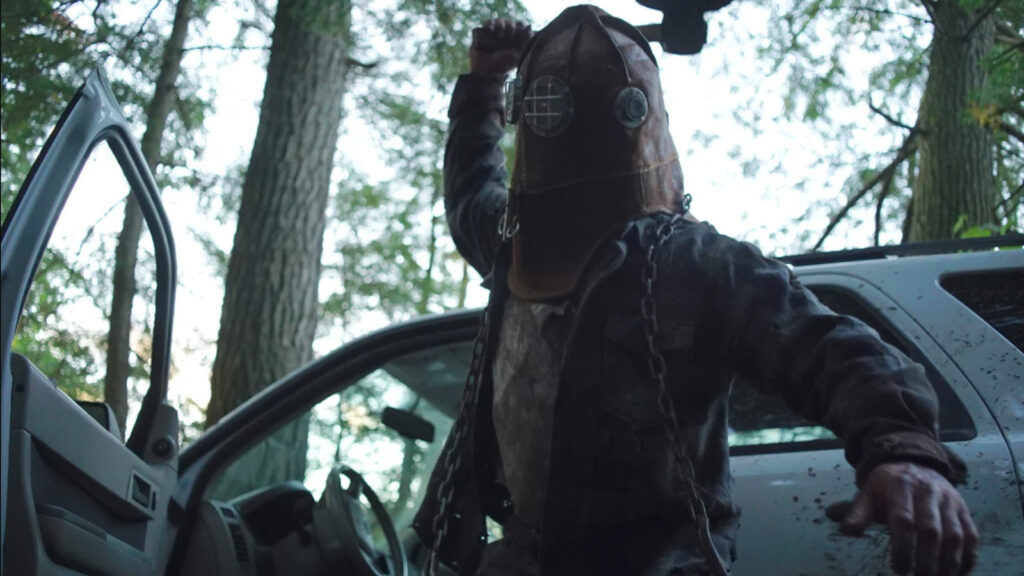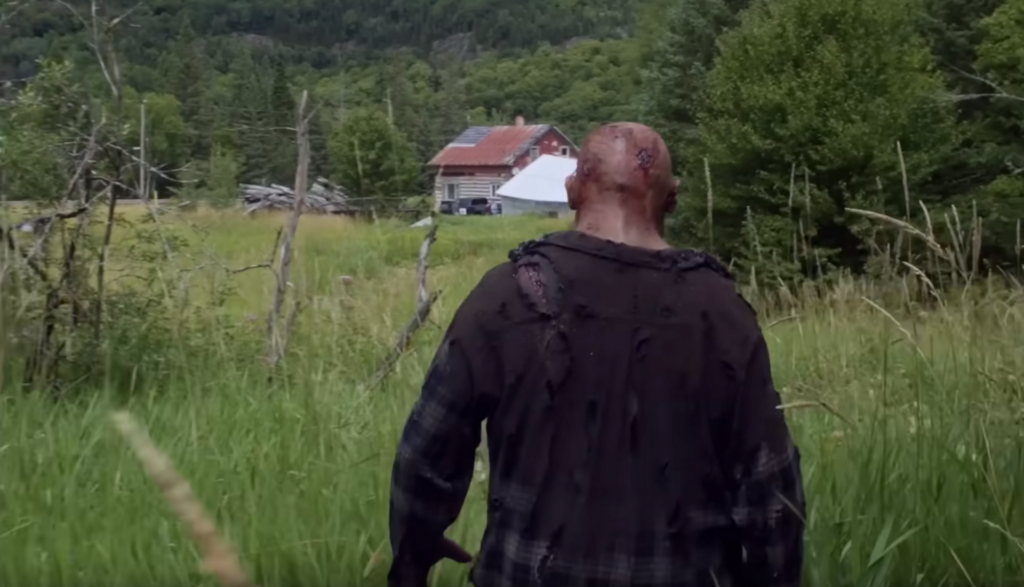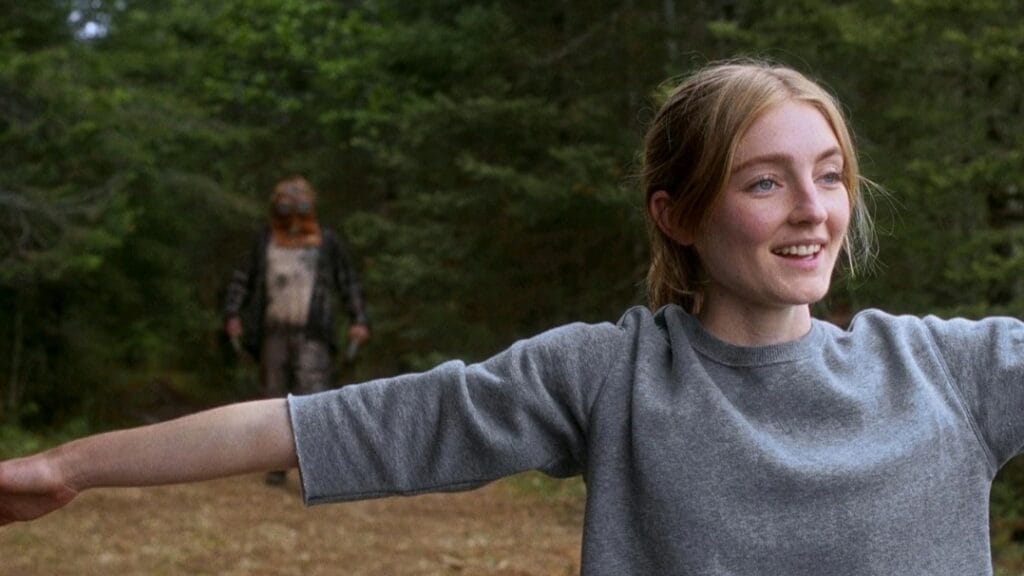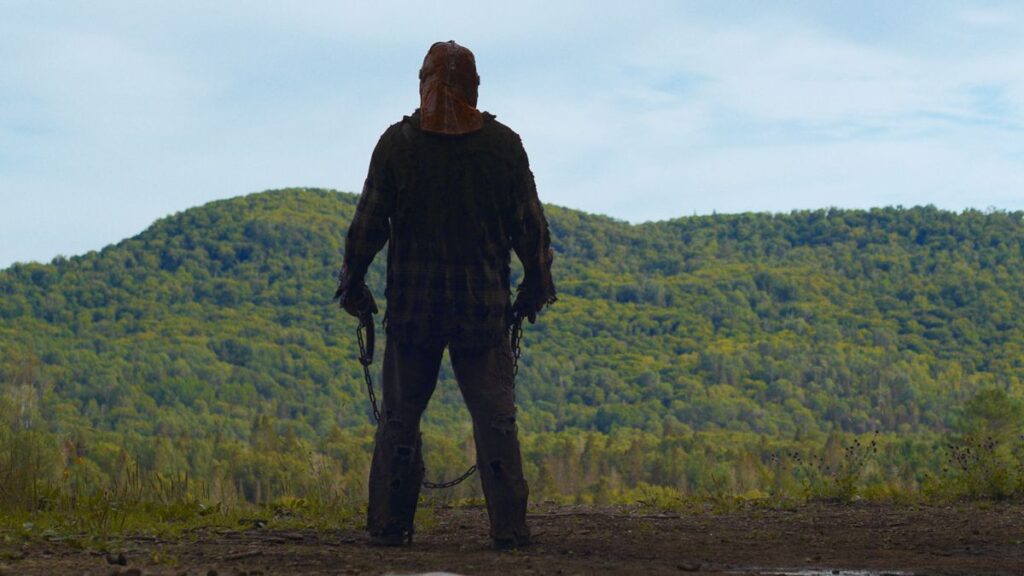
A campfire tale soaked in bile and blood, In a Violent Nature is a deeply unpleasant experience. This, of course, is the point; written and directed by Chris Nash, the movie is designed to unsettle its audience and subvert our expectations. By this measure, I suppose you could call it a success. But when judged against more traditional metrics—e.g., character development, thematic meaning, entertainment value, being vaguely interesting, etc.—it’s a failure.
Not a poorly made one, though. Making his first feature, Nash adopts a distinctive and coherent visual style, which he implements with considerable (albeit clammy) rigor. Operating within a cramped aspect ratio, his camera moves with a slow, purposeful glide, stalking its victims with deadly purpose. He refuses to use a musical score, instead relying on immersive sound design in which off-screen conversations are barely heard, like whispers in the woods. His technique isn’t found-footage horror—it’s methodical rather than chaotic—but it does fabricate a queasy, you-are-there intimacy. The result is like a Dardenne Brothers movie from hell—a ground-level observation of a supernatural monstrosity.
We meet the monster in the opening scene, which occurs at an abandoned fire tower. (Shooting took place in Ontario.) As a few voices babble about “the White Pines slaughter,” a hand reaches into frame and lifts a gold locket from a rusty pole. This seemingly innocuous act (note to horror characters: Stop seizing precious artifacts!) triggers a subterranean rumbling, and out of the ground pops Johnny (Ry Barrett), a hulking brute with a million-dollar arm and a bad temper. Over the next hour and a half, the camera rarely leaves Johnny’s side, instead literally following him—often focusing on the back of his bulbous head, which is pocked with bruises and blood spots—as he terrorizes the wandering saps who were foolish enough to awaken him.

The conceptual hook of In a Violent Nature is that it’s a slasher movie which unfolds from the slasher’s perspective. In most horror pictures, the killer is an unseen boogeyman, periodically bursting onto the scene to carve up some hapless victims but otherwise lurking in the shadows; his menace lies in his absence. Nash takes the opposite tack, allowing you to spend time with the villain as he goes about the drudging work of turning unsuspecting cabin-dwellers into corpses.
Does that sound cool to you? I can see how it might; the elevator pitch of “It’s Halloween, but from Michael Myers’ POV!” has a catchy feel to it. But in striving to topple the horror genre’s conventions, Nash ends up affirming their essentiality. And in centering the movie on Johnny, he has created an artistic black hole, one that engulfs everything in its wake with its oppressive nihilism and senseless brutality.
It should go without saying that the putative characters in a film like this function as fodder rather than people, but In a Violent Nature seems to take pride in rendering its victims insufferable. Most of what we learn about them comes from a campfire sequence (naturally, Johnny skulks in the background), when they spout some tedious mythology, make a few dick jokes, and lob terms like “cancel culture.” There’s no rule that horror figures need to be sympathetic, but they should at least be interesting; here, with no personality traits to latch onto, there’s no tension to be derived from whether they live or (far more likely) die.

Yet the real flaw of In a Violent Nature is that its very premise deprives it of the oxygen that horror films rely on: fear. Johnny, with his creepy fireman’s mask and vicious drag hooks, is an inexorable force of (ahem) nature; there’s no doubting the lethality of his enterprise or the intensity of his persistence. But because we see what he sees, the movie offers no surprises; he selects a target, executes them with extreme prejudice, then moves on. We know pretty much everything that’s going to happen before it happens, neutering any potential trepidation. It’s bizarre that, for a picture so heavily perfumed with the stench of incipient death, it isn’t remotely scary.
Nash attempts to compensate for this shortcoming by delivering a level of gore that’s both extreme and versatile. Johnny may be “mentally hindered,” but he’s an inventive butcher, and some of his slayings are impressively grotesque; one in particular, in which a woman’s very anatomy is rearranged, will likely take its place in the annals of Gnarly Screen Kills. But even here, Nash proves too proud of himself; a late murder involving a log splitter drags on endlessly, while other shots of axes embedding themselves into skulls are too repetitive to be disturbing.

For its climax, In a Violent Nature violates its own self-imposed schema, departing Johnny’s company and instead concentrating on an ostensible final girl (Andrea Pavlovic). This sequence, involving an untrustworthy passerby and a painful tourniquet, is the movie’s most conventional scene. It is also its most successful, acquiring a shiver of suspense that you might even call dread.
But the anxiety of that passage only underscores the rest of the film’s plodding pointlessness. As a director, Nash isn’t untalented; he manufactures some striking images, like the match cut of a grasping hand before and after a bloody kill, and he disdains hoary jump scares in favor of… well, what? Not momentum, not excitement, and certainly not pleasure. In essence, In a Violent Nature represents the thoughtful execution of a fundamentally stupid idea. Johnny can’t be stopped, which is exactly why this ambitious, sadistic movie never gets started.
Grade: C
Jeremy Beck is the editor-in-chief of MovieManifesto. He watches more movies and television than he probably should.
